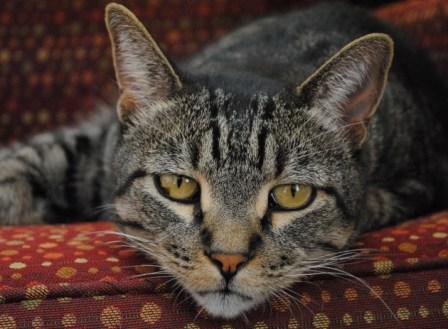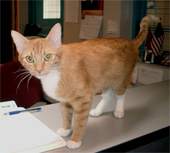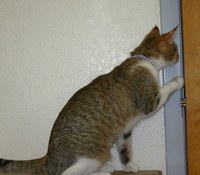Owning A Cat

Behavior
If you are having difficulties with your pet, Animal Welfare Department is here to help. Call 311 and ask for behavior help and someone will be touch with you.
Answers to Your Cat Questions
- Should I adopt a cat?
- How much does adoption cost?
- How can I get my cat spayed or neutered?
- Does my cat need a microchip?
- There are stray cats in my neighborhood. What should I do?
- How do I keep cats out of my garden or my yard?
Spraying
Urine marking outside of the litter box, accompanied in either a crouching or standing position, occurs in sexually intact or neutered male or female cats. Urine marking in the standing position is called spraying. It is performed by males and by females.
Inappropriate elimination should not be viewed as intentional acts of malice or revenge. Cats that have been neutered at the appropriate age and that have never roamed outdoors or even seen another cat may begin to eliminate outside the litter box. Neutering is unlikely to prevent urine marking, given the right set of circumstances. A sexually intact cat that has begun to urinate inappropriately, however, should be neutered without delay. The hormonal influences related to reproduction may motivate urine marking.
A cat's failure to urinate appropriately in the litter box may have several causes. A dirty litter box may cause a cat to avoid the box. One cat may faithfully use a box that is only cleaned once or twice a week, while another cat may avoid a box that has been used just once. Urine contains odors that identify the individual and mark a cat's territory. The location of food, water and safe places to rest are linked to a cat's sense of security within its territory. If these are disturbed or if a sensitive cat is disturbed for any reason, it may reaffirm its territorial claim and relieve anxiety by urine marking. Litter training is further complicated in households with more than one cat. An easily offended cat may avoid a box that has been used by a housemate, while another may be attracted to void in the box to cover the odors left by others.
Territorial conflict between cats in multi-cat households may cause problems relating to the use of the litter box. One cat may wait near the litter box to ambush another cat when it attempts to use the box. An increased level of anxiety could lead to inappropriate elimination. The longer the urine marking is allowed to continue, the more enduring the pattern may become and more difficult it may be to resolve. This behavior is self-reinforcing, increasing the likelihood that the cat will do it again. Inappropriate urination may continue because of environmental factors that have little or nothing to do with the initial cause, which may never be determined.
A cat can develop certain target preferences such as carpeting, and eventually mark all those surfaces throughout your home. Certain sounds or even certain times of the day may trigger marking. The problem can rapidly become complex. Regardless of the initial trigger, inappropriate elimination may reappear in times of stress because the act immediately relieves anxiety.
Tips in Preventing Elimination
- Do not scold or startle a cat in the vicinity of its litter box. A negative experience associated with the litter box could result in avoidance.
- Provide one litter box for every cat in your household. Choose a variety of locations in quiet corners of your home to see which box attracts the most use. A cat that is harassed by others, even in play, should have an alternative box.
- See your veterinarian on a regular basis so that physical problems can be detected early. Consult your veterinarian early when you detect a problem.
- Long-haired cats, such as Persians, or Himalayans, are more easily soiled by urine or stool around the anus, tail, thighs, and paws. Segments of stool may adhere to their long hair and later fall off or be removed by the cat during grooming. Cats remove adhered feces by pulling out the soiled hair or by rubbing against the floor. Punishing cats for fecal soiling is not effective and only confuses your pet and makes it more anxious. Instead, a professional groomer or veterinary technician can carefully trim the long hair beneath the tail, around the anus and genitals, and at the back of the thighs. This makes maintenance grooming much easier.
- Cats have a natural instinct to dig in soil or sand for voiding. The litter box is an artificial invention, and it is surprising that more cats do not eliminate in potted plants. To discourage your cat from eliminating inappropriately in your houseplant pots, devise ways to prevent access. Suspend plants or place them on an elevated surface or in a room that is off limits to your cat. If it is inconvenient to isolate the plant, cover the soil with wire mesh or aluminum foil. Leave this cover in place as long as your cat shows any interest in returning there. Above all, keep the litter box especially clean so your cat has no reason to avoid it.
Litter Box

From a young age, cats have a strong instinct to void in sand or soil. Typically, cats dig to prepare a shallow hole. More digging usually follows to cover its waste. Cats exhibit a wide range of normal behaviors relating to elimination. Some normal cats do not cover waste, while other enthusiastically dig before and after voiding.
To encourage kittens to use the litter, gently place the kitten in the pan soon after each meal. If the kitten has had an accident outside the box, simply place the mess inside the box to help the kitten make the desired association. Punishment is never necessary, as kittens usually learn quickly. Avoid disturbing your cat while it is using the box and never punish it for any reason when it is near the box.
The Litter Box and Litter Materials
Many types of litter boxes and litter materials are available to cat owners. Litter boxes or pans are generally rectangular plastic containers. The box size should be large enough to comfortably accommodate an adult cat. The sides of the pan should be low enough for easy access by a kitten or an ailing adult cat. (For these cats you may consider replacing a standard litter pan with any suitable container.)
Care of Litter Box
The most important thing to encourage litter box use is cleanliness. Cats are very clean animals that avoid foul-smelling and damp places. Consider not what you think is clean, but what your cat considers acceptable. Change the litter completely and frequently at regular intervals, using the manufacturer's recommendation as a guideline. Each cat has its own tolerance of litter box contamination and may avoid using the box if it is too dirty. As a rule of thumb, provide one litter pan for every cat in your household. If you have more than one litter box, you may find that some are used more than others. This may reflect your cat's preference for location or dissatisfaction with litter hygiene, suggesting that you should reconsider box placement or change the litter more often. Cats in multi-cat households often share litter boxes, but some are less tolerant of soiled litter boxes. Though you may have several boxes in your home, you must keep them clean to ensure regular use.
- Covered litter boxes are available in a variety of styles and may substantially reduce odors. Some litter covers have charcoal filters that further reduce odor. You can purchase a litter pan without a cover, but ask whether a cover may be added later, just in case.
- A standard covered box requires the cat to step into an opening in the cover's front. Other models require the cat to enter and exit through an elevated opening. The top portion of a covered box can also be removed and placed upside down as an alternative litter pan for cats that tend to void over the edges or are unsteady because of age or illness.
Cats are not born with an instinct to eliminate on unnatural litter filler. Their natural choice is sand or soil. A wide variety of litter filler is marketed to attract the cat owner. In choosing a litter filler, consider first and foremost what your cat prefers. Some cats may have no preference, while others are surprisingly choosy. It is probably best to begin with a product that is basic and simple. The dust or scent of perfumed or deodorizing filler materials may be disturbing to some cats. Others may prefer fine sand-like filler or even shredded newspaper. If you decide on a new brand, your cat might adjust more smoothly if the two litters are mixed for a time.
Litter Box Location
Cats prefer to eliminate in boxes that are placed in a quiet location, such as a corner away from busy areas. Place the litter pan well away from a food dish or water bowl. It is important to never block access to the litter box. Consider placing an additional box at a different location.
Unscreened Windows – Cat Caution

Cat owners are seemingly unaware of what vets are calling High-Rise Syndrome. During the summer months, cat owners open their windows to enjoy the breeze, but at the same time, put their cats at potential harm. Unscreened windows pose a real danger to cats as they become intrigued by a passing bird or wind-carried leaf, and fall out. These accidents can result in shattered jaws, punctured lungs, broken limbs and pelvises—and even death.
The City of Albuquerque Animal Welfare Department points out these common cat myths:
- Cats have excellent survival instincts, and they don’t deliberately jump from high places that would be dangerous.
- Cats have an incredible ability to focus their attention on whatever can become distracting enough to cause them to lose their balance and fall.
- When cats fall from high places, they don’t land squarely on their feet. Instead, they land with their feet slightly splayed apart, which can cause severe head and pelvis injuries.
The Animal Welfare Department encourages cat owners to make sure that snug and sturdy screens are installed on all windows and that cats are required to be indoor companions. Cats are susceptible to outside dangers such as cars, other animals and disease if allowed to roam outside. Animal Welfare receives hundreds of lost cats and kittens due to no identification.
